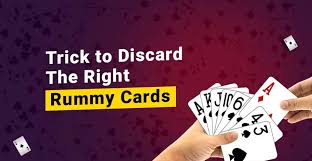Rummy Do You Have To Discard, is a classic card game beloved for its blend of skill, strategy, and luck. Central to the gameplay of Rummy is the act of discarding cards, a crucial element that influences the outcome of each round and the overall game. This article delves into why discarding is an essential part of Rummy, how it impacts strategy, and tips for making effective discards.
The Role of Discarding in Rummy
1. Essential Gameplay Mechanism: In Rummy, discarding is not just a routine action but a fundamental component of the game. At the end of each turn, players must discard one card from their hand. This process helps manage hand size and can strategically influence both the player’s own game and that of their opponents.
2. Completing Melds: The primary goal in Rummy is to form valid melds, which include sets (three or four cards of the same rank) and runs (three or more consecutive cards of the same suit). Discarding is crucial for managing your hand and making room for new cards that might help you complete these melds.
3. Reducing Deadwood: Deadwood refers to unmelded cards left in a player’s hand at the end of a round. Discarding helps in minimizing deadwood by removing cards that are less useful and focusing on those that contribute to forming valid melds.
Strategic Discarding
1. Discarding for Advantage: Strategic discarding involves more than just getting rid of excess cards. It can be used to achieve specific game objectives and influence opponents. Here’s how:
- Keeping Key Cards: Retain cards that are likely to form part of a valuable meld. For example, if you have a sequence of 5-6-7 in hearts, keep related cards or potential cards that can extend the sequence.
- Bluffing and Misleading: Discard cards that might lead opponents to believe you are working towards a certain meld, while you actually pursue a different strategy.
- Blocking Opponents: If you notice that an opponent is picking up cards that could help them, consider discarding cards that might complete their melds or obstruct their progress.
2. Avoiding High-Value Deadwood: High-value cards such as face cards (J, Q, K) and aces can add significantly to your deadwood points. Discard these cards early if they do not fit into any meld you are forming, to reduce potential penalties if another player goes out.
3. Timing Your Discards: Discarding is also about timing. For instance, in some Rummy variations, it’s advantageous to discard cards that are less likely to help your hand but might also be less useful to opponents. Conversely, if you’re close to going out, consider holding onto cards that could help you finalize your melds.
The Impact of Discarding on the Game
1. Game Dynamics: The process of discarding affects the flow of the game. Players must adapt their strategies based on the cards they draw and the ones they discard. This constant adjustment is what makes Rummy both challenging and engaging.
2. Scoring and Winning: In Rummy, a player goes out by forming valid melds and discarding their final card. Effective discarding is key to reaching this point and achieving a favorable score. Players who master the art of discarding often find themselves at an advantage, as they can better manage their hands and respond to opponents’ actions.
3. Psychological Aspects: Discarding can also involve psychological elements. Skilled players can use their discards to mislead opponents about their actual hand, creating opportunities to advance their own position while keeping their strategy concealed.
Tips for Effective Discarding
1. Assess Your Hand: Regularly evaluate your hand to determine which cards are least useful. Prioritize discarding cards that do not contribute to any potential melds.
2. Observe Opponents: Pay attention to the cards discarded by opponents. This can provide clues about their strategies and help you make more informed decisions about which cards to keep or discard.
3. Adapt to the Flow: Be flexible and adapt your discarding strategy based on the evolving state of the game. Adjust your approach as you draw new cards and as the game progresses.
4. Practice and Experience: Like many aspects of Rummy, effective discarding improves with practice. The more you play, the better you’ll become at making strategic decisions about which cards to discard.
Conclusion
Discarding is a fundamental aspect of Rummy that plays a crucial role in shaping the strategy and outcome of the game. Understanding the importance of discarding, employing strategic approaches, and adapting to the game’s dynamics can significantly enhance your Rummy skills. Whether you are a seasoned player or new to the game, mastering the art of discarding will improve your chances of success and make your Rummy experience more enjoyable. So, gather your cards, apply these strategies, and get ready to excel in your next Rummy game.




